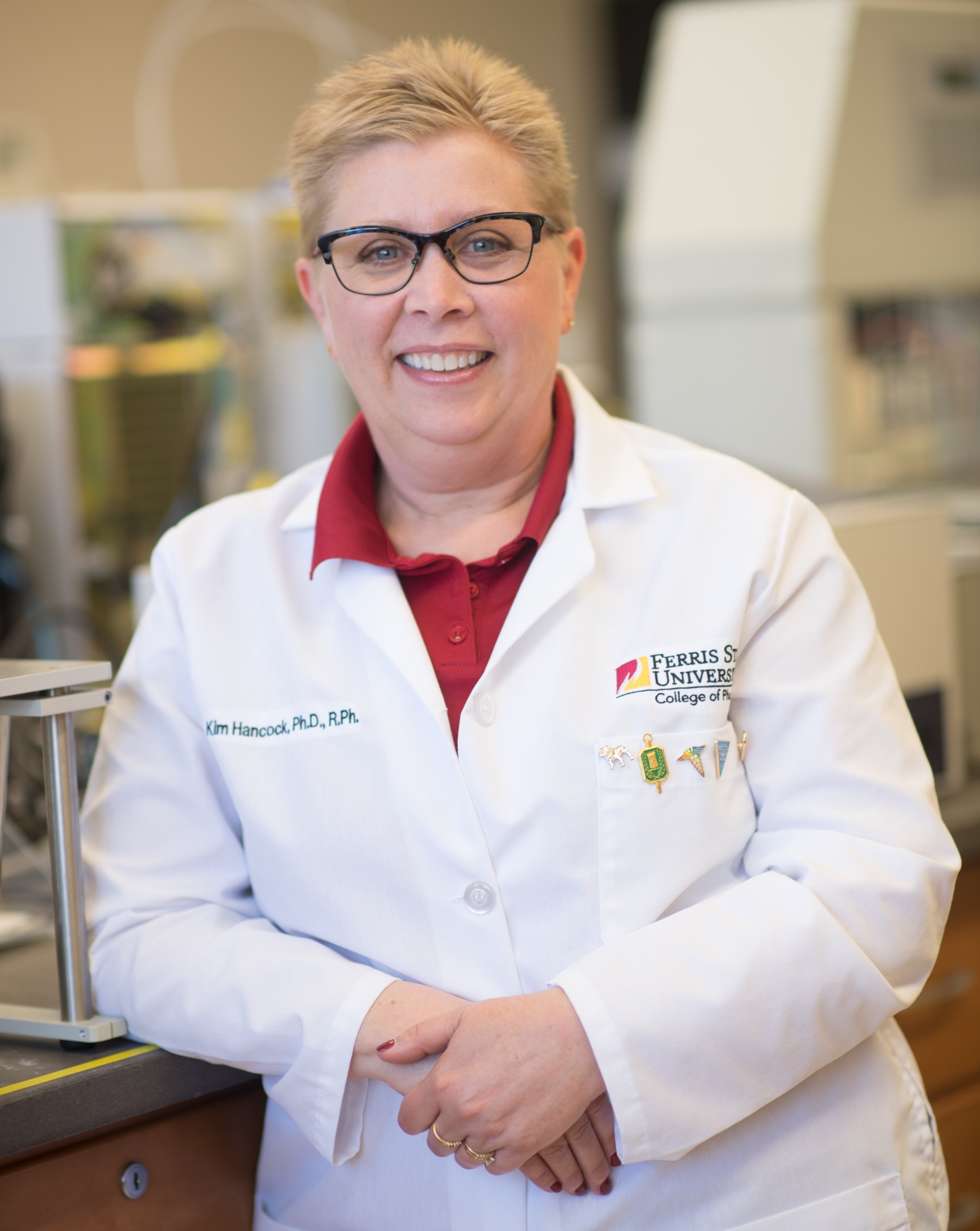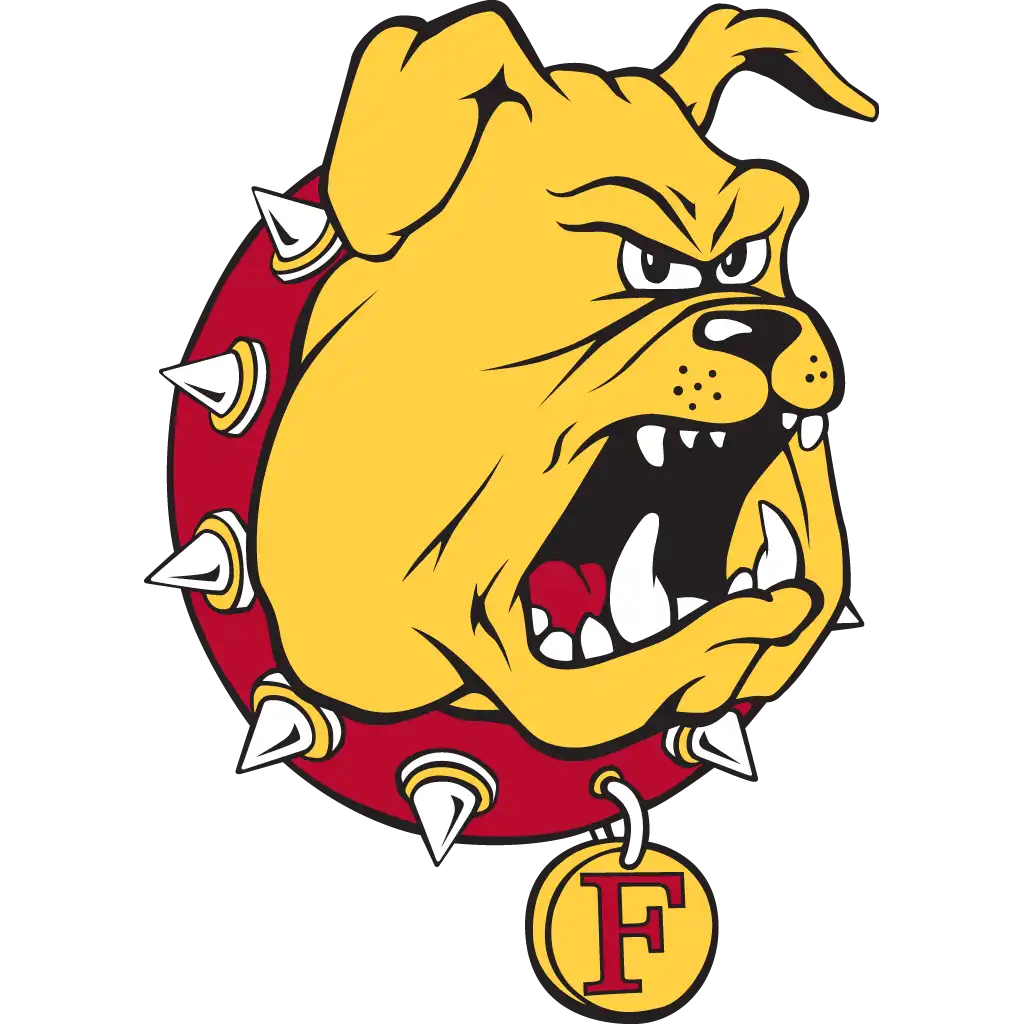Professor, Pharmaceutics in the College of Pharmacy
by John Smith - Dec. 20, 2022

Kim Hancock
An interest in science and a couple of significant influencers in Marshall, Michigan, started Ferris State University Professor of Pharmaceutics Kim Hancock on her learning journey that has had her arrive at and return to continue those goals on campus in Big Rapids.
“I took an after-school job at Geiger Pharmacy, where the owner Richard Geiger (Class of 1960) and his assistant Kenneth Eagle (Class of 1941) had earned their pharmacy degrees at Ferris State College and Ferris Institute, respectively,” Hancock said. “I was doing odd jobs, but they both knew I had a passion for science, which led them to encourage me to apply at Ferris.”
Hancock started at Ferris in 1983 and found a mentor in professor of Pharmaceutics Bill Smith as she worked to complete her Bachelor of Science in Pharmacy.
“I had many great teachers in pre-Pharmacy and the College of Pharmacy, but he was the instructor who helped me to see what kind of career I could have by entering graduate school,” Hancock said. “I went to work at Upjohn in Kalamazoo (now known as Pfizer), where I was encouraged to earn my Ph.D. Bill stayed in contact with me and, in 1995, made his case for replacing him on the faculty at Ferris.”
With her professional experience in manufacturing and doctoral studies in Industrial and Physical Pharmacy augmenting her Bachelor of Science at Ferris, Hancock considered the possibilities that a career in industry or education would present her.
“I had interesting and valuable opportunities to consider, but the choice to return to Ferris was right, both for my mind and my heart,” Hancock said. “At its core, Ferris’ Pharmacy school is a teaching school but also focuses on scholarship, which has always been important to me. I am so glad to see the level of research that my peers have established and continue here. The transition in recent years has been interesting for all of us, but I know my service to my alma mater is equally important, and I enjoy every day in the classroom.”
As she began her role as a professor at Ferris in 1995, Hancock felt at home joining professors who were now her colleagues.
“Ron Jacoby and Gerald ‘Jerry’ Slykwa became mentors. They made it clear that the job was based on my ability to learn rather than to simply teach my students,” Hancock said. “The teaching and the learning fold together, and my advances as a learner are a constant.
I was using overhead projectors in a classroom setting when I began, having now moved on to a ‘Flipped Classroom’ where active learning is the heart of the classroom, and students work in groups to solve problems.”
Embracing technology is an important aspect of her instruction.
“My lectures are recorded and delivered through our course management system and available for students to access and learn from 24/7,” she said. “This method helps students to self-assess and learn by taking low-stakes quizzes individually and as a group before their more crucial exams. I built the course structure and progression of content to assure that students know and can master the material that is expected of them.”
This online component offers students opportunities to assess while they continue learning.
“It is comforting to know my online content is full of exercises that allow them to learn and apply this material rather than memorize it,” Hancock said.
The onset of the pandemic was also a significant time for Hancock. It signaled a pause for her as a researcher and academic presenter.
“My latest presentation dealt with the scholarship of teaching and learning, which found me with Lilia Caserta from the Languages, Literature and World Languages faculty in Kazan, Russia, just as COVID began to spread and impact travel,” Hancock said. “Making the return trip from Russia was a challenging personal experience. I contracted the virus early, and thankfully, I recovered quickly. I have been proud of my research work and welcome the opportunity for that to continue when it is appropriate.”
Hancock said learning and the effort of instruction were put to the test as she had to support an academic rotation with fourth-year College of Pharmacy students entirely online.
“Even in Fall 2020, the College of Pharmacy taught classes in a hybrid fashion, offering students the choice to attend classes face to face or online, so this was a demanding experience for all of us,” she said. “I feel for Pharmacy students who tried to do their best and learn when the traditional learning structure they were comfortable with was ripped from under them.”
Hancock considers the last two and a half years to be another chapter of her time as a professor with the students in a gradual state of change.
“I won’t deny that students have changed, but that is mostly because of the permeation of technology,” she said. “What has been a constant is their basic desire to become pharmacists, to make that personal investment to reach that level of learning and understanding. They have showed they can do this, which is no small feat in the ‘wired world’ that has its effect on any of us.”
Hancock’s support of learning extends beyond the Pharmacy classrooms, as she serves as Ferris’ faculty athletic representative to the National Collegiate Athletic Association.
“The student-athletes and coaches refer to me as the ‘FAR,’ the Faculty Athletic Representative,” Hancock said. “The main responsibility of the FAR is to be a primary point of contact outside of athletics focused on a student athlete’s physical and mental well-being, as well as academic support. Our athletes know they can come to me, which I work to reinforce by attending their games and practices when possible. Because I am outside of Athletics, student-athletes sometimes feel more comfortable reaching out to me.”
Hancock added, “Another facet of serving the university in this role means I must be active in institutional oversight. If there is anything I see that could present an NCAA violation for one of our teams, it is my duty to point that out.”
Hancock said she understands observers may perceive her role with Athletics as a ceremonial position. Still, she feels the duties on behalf of the NCAA and the university have real meaning and impact.
“It is another example of how the pandemic called for a response from Ferris’ athletes, faculty and staff,” Hancock said. “I was involved in the COVID testing as the pharmacist in charge. It was a necessary role to ensure the safety of our athletes and their opponents during the 2020-21 academic year. “
Hancock’s service as NCAA faculty athletic representative has another benefit, as it nurtures her ability to take in Bulldogs sports throughout the academic year.
“I love to go to as many games as possible,” Hancock said. “I went to McKinney, Texas, in 2018 for Ferris’ first try at the national championship in football, and we had a great time in 2021 as the Bulldogs earned the Division II title. Now, I have a FloSports account, so I can see more of our athletes, whether they are competing at home or on the road.”
Kim said in conclusion that her role with Athletics is another opportunity to work with and learn from students, which she finds joyful.
“I very much appreciate how open students are with me when it comes to difficult situations,”
Hancock said. “A great deal of academic assistance is available to them, along with
other counseling opportunities. When I am approached as a representative, I recognize
the athlete may be reluctant to reach out in any other fashion. I try to help them
understand all the efforts being made for their benefit, and they are very grateful
for that kind of support.”
John Smith is a communications specialist for News Services and Social Media in University Advancement and Marketing.

